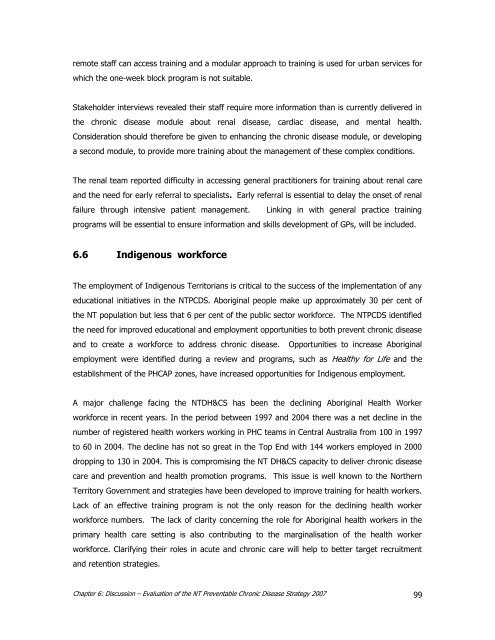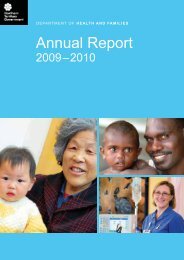PCD Strategy Evaluation 2007.pdf - NT Health Digital Library ...
PCD Strategy Evaluation 2007.pdf - NT Health Digital Library ...
PCD Strategy Evaluation 2007.pdf - NT Health Digital Library ...
Create successful ePaper yourself
Turn your PDF publications into a flip-book with our unique Google optimized e-Paper software.
emote staff can access training and a modular approach to training is used for urban services forwhich the one-week block program is not suitable.Stakeholder interviews revealed their staff require more information than is currently delivered inthe chronic disease module about renal disease, cardiac disease, and mental health.Consideration should therefore be given to enhancing the chronic disease module, or developinga second module, to provide more training about the management of these complex conditions.The renal team reported difficulty in accessing general practitioners for training about renal careand the need for early referral to specialists. Early referral is essential to delay the onset of renalfailure through intensive patient management. Linking in with general practice trainingprograms will be essential to ensure information and skills development of GPs, will be included.6.6 Indigenous workforceThe employment of Indigenous Territorians is critical to the success of the implementation of anyeducational initiatives in the <strong>NT</strong><strong>PCD</strong>S. Aboriginal people make up approximately 30 per cent ofthe <strong>NT</strong> population but less that 6 per cent of the public sector workforce. The <strong>NT</strong><strong>PCD</strong>S identifiedthe need for improved educational and employment opportunities to both prevent chronic diseaseand to create a workforce to address chronic disease. Opportunities to increase Aboriginalemployment were identified during a review and programs, such as <strong>Health</strong>y for Life and theestablishment of the PHCAP zones, have increased opportunities for Indigenous employment.A major challenge facing the <strong>NT</strong>DH&CS has been the declining Aboriginal <strong>Health</strong> Workerworkforce in recent years. In the period between 1997 and 2004 there was a net decline in thenumber of registered health workers working in PHC teams in Central Australia from 100 in 1997to 60 in 2004. The decline has not so great in the Top End with 144 workers employed in 2000dropping to 130 in 2004. This is compromising the <strong>NT</strong> DH&CS capacity to deliver chronic diseasecare and prevention and health promotion programs. This issue is well known to the NorthernTerritory Government and strategies have been developed to improve training for health workers.Lack of an effective training program is not the only reason for the declining health workerworkforce numbers. The lack of clarity concerning the role for Aboriginal health workers in theprimary health care setting is also contributing to the marginalisation of the health workerworkforce. Clarifying their roles in acute and chronic care will help to better target recruitmentand retention strategies.Chapter 6: Discussion – <strong>Evaluation</strong> of the <strong>NT</strong> Preventable Chronic Disease <strong>Strategy</strong> 2007 99
















